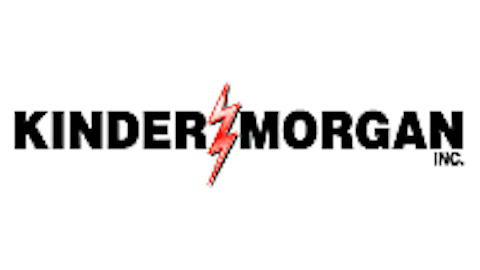Based on combined enterprise value, Kinder Morgan Inc (NYSE:KMI) is the third-largest energy company in North America. We tend to associate the giant with its 75,000 miles of pipelines, but in reality its operations are incredibly diverse. Over the past week, I’ve taken a closer look at each of the midstream company’s five distinct business units: So far I’ve reviewed terminals, natural gas pipelines, products pipelines, and Kinder Morgan Canada. Today we dig into the last business segment, one of the least understood parts of the partnership’s operations: CO2.
Background on the assets
Kinder Morgan Inc (NYSE:KMI) is at the top of the heap when it comes to the CO2 business, serving as North America’s leading transporter and marketer of the gas. The company delivers about 1.3 billion cubic feet per day through its 1,300 miles of CO2 pipe.

Before we get into the nitty-gritty of Kinder Morgan’s assets (which are technically owned by Kinder Morgan Energy Partners LP (NYSE:KMP), let’s remind ourselves of what the CO2 business actually is.
Most often, when it comes to energy production, carbon dioxide is the enemy. However, in the mature oil fields of West Texas, carbon dioxide is an oil man’s best friend. The gas is injected into a well at high pressure, in a process called flooding, to force out every last bit of oil. Companies such as Occidental Petroleum Corporation (NYSE:OXY) in the Permian Basin and Denbury Resources Inc. (NYSE:DNR) on the Gulf Coast have used enhanced oil recovery, or EOR, to maximize output. The process is often called tertiary recovery, because it’s the third step after normal production, followed by water flooding.
Kinder Morgan Inc (NYSE:KMI) engages in the transportation of CO2, selling it to customers in the Permian, but it also uses it to produce oil. The partnership has four CO2 source fields in Arizona, New Mexico and Colorado, and three oil-producing fields in Texas. Its assets also include the requisite CO2 and oil pipelines.
In 2012, oil production at Kinder Morgan’s SACROC field beat management’s expectations by more than 1,000 barrels per day, and it was the same story with NGL production. However, as many midstream industry fans know, the NGL price collapse last year really hurt, and Kinder Morgan was no exception, suffering a $59 million impact on distributable cash flow.
Let’s look at how the segment’s assets performed in 2012 compared with management’s expectations. Note that the CO2 producing fields and pipelines are grouped together as “Source & Transportation,” or S&T:
| Asset | Expected | Actual | Difference |
|---|---|---|---|
| SACROC (oil) | 27,868 Bbl/D | 28,968 Bbl/D | 3.8% |
| SACROC (NGL) | 17,361 Bbl/D | 18,825 Bbl/D | 7.8% |
| Yates | 20,986 Bbl/D | 20,839 Bbl/D | (0.7%) |
| Katz | 2,267 Bbl/D | 1,722 Bbl/D | (24%) |
| CO2 S&T | 1,264 Mmcf/D | 1,212 Mmcf/D | (4.1%) |
Source: Company presentation.
A combination of high oil prices and higher production at SACROC allowed Kinder Morgan Inc (NYSE:KMI) to partially mitigate lower production at Katz and lower realized NGL prices at SACROC in 2012. Even though production missed estimates at Yates, Katz, and S&T, distributable cash flow targets missed only at Katz and SACROC.
The segment generated the second-highest earnings for Kinder Morgan in the fourth quarter, growing 20% to reach $337 million, bringing in $1.3 billion for the full year. While many expected this segment to decline, it did no such thing, and management expects to grow distributable cash flow again in 2013.
A look ahead
It’s no secret that oil production in Texas is climbing again, and that will really benefit Kinder Morgan Inc (NYSE:KMI) going forward. The partnership plans to spend $632 million building up the CO2 segment in 2013, including overhead and CO2 purchases. The majority of the funds will be allocated to SACROC (40%) and S&T (42%).
SACROC and Katz remain the assets most susceptible to commodity risk. This is something investors can monitor, and there should be no reason for surprises come earnings time. All told, Kinder Morgan expects to generate $1.38 billion in distributable cash flow from this segment for the full year, which would be about $65 million more than its performance in 2012.
The future of this segment really is all about demand. Obviously, if demand remains strong, the segment has a bright long-term outlook. But increased demand also improves contract terms for Kinder Morgan, which brightens the short-term outlook as well. High oil prices have encouraged producers to get more bang for their buck, increasing purchases of CO2. Demand is growing in the Permian Basin, but the partnership has identified opportunities long-term in regions outside this traditional hotbed, including the Gulf Coast, California, the mid-continent region, and Canada.
Foolish takeaway
Kinder Morgan Inc (NYSE:KMI)’s CO2 business unit once again demonstrates how multifaceted this midstream operation really is. What makes the partnership such a compelling investment is that in the end, you really are buying into one of the most diversified energy companies on the market.
The article Inside Kinder Morgan: CO2 originally appeared on Fool.com.
Fool contributor Aimee Duffy has no position in any stocks mentioned. Click here to see her holdings and a short bio. If you have the energy, follow her on Twitter, where she goes by @TMFDuffy. The Motley Fool recommends Kinder Morgan and owns shares of Denbury Resources and Kinder Morgan.
Copyright © 1995 – 2013 The Motley Fool, LLC. All rights reserved. The Motley Fool has a disclosure policy.



